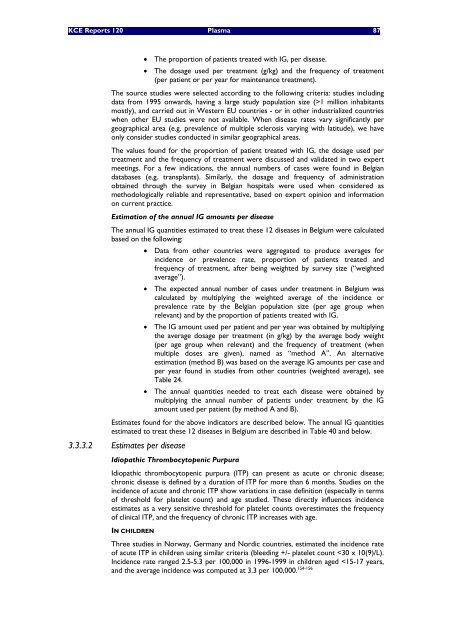The report is available in English with a French summary - KCE
The report is available in English with a French summary - KCE
The report is available in English with a French summary - KCE
You also want an ePaper? Increase the reach of your titles
YUMPU automatically turns print PDFs into web optimized ePapers that Google loves.
<strong>KCE</strong> Reports 120 Plasma 87<br />
• <strong>The</strong> proportion of patients treated <strong>with</strong> IG, per d<strong>is</strong>ease.<br />
• <strong>The</strong> dosage used per treatment (g/kg) and the frequency of treatment<br />
(per patient or per year for ma<strong>in</strong>tenance treatment).<br />
<strong>The</strong> source studies were selected accord<strong>in</strong>g to the follow<strong>in</strong>g criteria: studies <strong>in</strong>clud<strong>in</strong>g<br />
data from 1995 onwards, hav<strong>in</strong>g a large study population size (>1 million <strong>in</strong>habitants<br />
mostly), and carried out <strong>in</strong> Western EU countries - or <strong>in</strong> other <strong>in</strong>dustrialized countries<br />
when other EU studies were not <strong>available</strong>. When d<strong>is</strong>ease rates vary significantly per<br />
geographical area (e.g. prevalence of multiple scleros<strong>is</strong> vary<strong>in</strong>g <strong>with</strong> latitude), we have<br />
only consider studies conducted <strong>in</strong> similar geographical areas.<br />
<strong>The</strong> values found for the proportion of patient treated <strong>with</strong> IG, the dosage used per<br />
treatment and the frequency of treatment were d<strong>is</strong>cussed and validated <strong>in</strong> two expert<br />
meet<strong>in</strong>gs. For a few <strong>in</strong>dications, the annual numbers of cases were found <strong>in</strong> Belgian<br />
databases (e.g. transplants). Similarly, the dosage and frequency of adm<strong>in</strong><strong>is</strong>tration<br />
obta<strong>in</strong>ed through the survey <strong>in</strong> Belgian hospitals were used when considered as<br />
methodologically reliable and representative, based on expert op<strong>in</strong>ion and <strong>in</strong>formation<br />
on current practice.<br />
Estimation of the annual IG amounts per d<strong>is</strong>ease<br />
<strong>The</strong> annual IG quantities estimated to treat these 12 d<strong>is</strong>eases <strong>in</strong> Belgium were calculated<br />
based on the follow<strong>in</strong>g:<br />
• Data from other countries were aggregated to produce averages for<br />
<strong>in</strong>cidence or prevalence rate, proportion of patients treated and<br />
frequency of treatment, after be<strong>in</strong>g weighted by survey size (“weighted<br />
average”).<br />
• <strong>The</strong> expected annual number of cases under treatment <strong>in</strong> Belgium was<br />
calculated by multiply<strong>in</strong>g the weighted average of the <strong>in</strong>cidence or<br />
prevalence rate by the Belgian population size (per age group when<br />
relevant) and by the proportion of patients treated <strong>with</strong> IG.<br />
• <strong>The</strong> IG amount used per patient and per year was obta<strong>in</strong>ed by multiply<strong>in</strong>g<br />
the average dosage per treatment (<strong>in</strong> g/kg) by the average body weight<br />
(per age group when relevant) and the frequency of treatment (when<br />
multiple doses are given), named as “method A”. An alternative<br />
estimation (method B) was based on the average IG amounts per case and<br />
per year found <strong>in</strong> studies from other countries (weighted average), see<br />
Table 24.<br />
• <strong>The</strong> annual quantities needed to treat each d<strong>is</strong>ease were obta<strong>in</strong>ed by<br />
multiply<strong>in</strong>g the annual number of patients under treatment by the IG<br />
amount used per patient (by method A and B).<br />
Estimates found for the above <strong>in</strong>dicators are described below. <strong>The</strong> annual IG quantities<br />
estimated to treat these 12 d<strong>is</strong>eases <strong>in</strong> Belgium are described <strong>in</strong> Table 40 and below.<br />
3.3.3.2 Estimates per d<strong>is</strong>ease<br />
Idiopathic Thrombocytopenic Purpura<br />
Idiopathic thrombocytopenic purpura (ITP) can present as acute or chronic d<strong>is</strong>ease;<br />
chronic d<strong>is</strong>ease <strong>is</strong> def<strong>in</strong>ed by a duration of ITP for more than 6 months. Studies on the<br />
<strong>in</strong>cidence of acute and chronic ITP show variations <strong>in</strong> case def<strong>in</strong>ition (especially <strong>in</strong> terms<br />
of threshold for platelet count) and age studied. <strong>The</strong>se directly <strong>in</strong>fluences <strong>in</strong>cidence<br />
estimates as a very sensitive threshold for platelet counts overestimates the frequency<br />
of cl<strong>in</strong>ical ITP, and the frequency of chronic ITP <strong>in</strong>creases <strong>with</strong> age.<br />
IN CHILDREN<br />
Three studies <strong>in</strong> Norway, Germany and Nordic countries, estimated the <strong>in</strong>cidence rate<br />
of acute ITP <strong>in</strong> children us<strong>in</strong>g similar criteria (bleed<strong>in</strong>g +/- platelet count

















